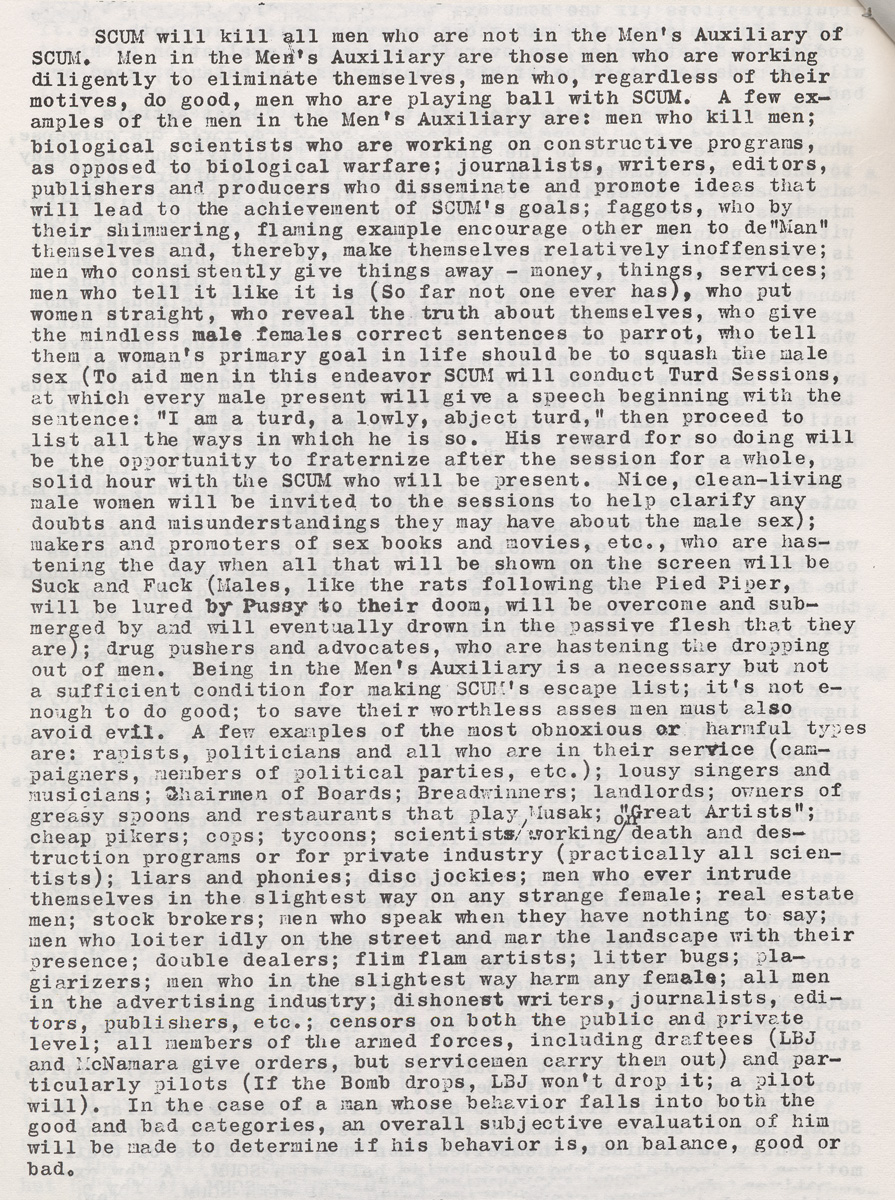Inventory / How to Join the Men’s Auxillary
Valerie Solanas and the enemies and allies of SCUM
Sasha Archibald
“Inventory” is a column that examines or presents a list, catalogue, or register.

Solanas’s manifesto builds on the premise that a man is an incomplete woman, the accidental result of an amputated chromosomal set. All of men’s actions in the world are designed to ameliorate and conceal—or project on others—their deficiencies as non-women. Solanas goes on to indict money (without it, men couldn’t retain women’s company); lack of privacy (having no inner lives, men are blind to those of women); social conformity (difference exacerbates men’s insecurity); philosophy (men’s effort to call their sorry condition that of all humanity); as well as the more conventional sex and war, as all stemming from men’s emotional, psychological, and intellectual inadequacies. Certain women are more indoctrinated by men’s lies than others; these “male-females,” as Solanas calls them, “too cowardly to face up to the hideous reality of what a man is, what Daddy is, who have cast their lot with the swine,” fare no better by her pen.
SCUM was not, as Solanas clarified in a 1977 Village Voice interview, a real organization: “It’s hypothetical. No, hypothetical is the wrong word. It’s just a literary device. There’s no organization called SCUM... It’s not even me... I mean, I thought of it as a state of mind. In other words, women who think a certain way are in SCUM. Men who think a certain way are in the men’s auxiliary of SCUM.”[1] The SCUM Manifesto announces five major objectives: secure universal free transportation; “couple-bust” (heterosexual only); destroy “useless and harmful objects” such as “cars, store windows, ‘Great Art,’ etc.”; flood the workforce with women who will then instigate the “fuck-up force,” i.e., anarchist sabotage on a grand scale; and finally, kill all men except those in what she called the Men’s Auxiliary (admission guidelines for which are reproduced on the preceding page.)

The guidelines typify the witty logorrhea of Solanas’s prose, as well as her sometimes convoluted logic. One thing, however, immediately becomes clear: the men’s auxiliary was not Solanas’s concession to a few good men, but rather a designation for enemies inadvertently working in her favor. “Which men deserve to live?” is not her question so much as “How much evil does one tolerate in an ally?” The first criteria presented indicate types of men to be included in the Men’s Auxiliary. However, “[b]eing in the Men’s Auxiliary is a necessary but not sufficient condition for making SCUM’s escape list.” Solanas goes on to furnish a second set of criteria by which the safety afforded by inclusion is nullified. A drug dealer may be admitted to the Men’s Auxiliary for his corroborative role in eliminating men by promoting lethal drug addiction. But, if he’s a drug dealer in the habit of sitting on stoops and “mar[ring] the landscape” with his presence, he is no less an enemy to SCUM than any other man.
The Men’s Auxiliary was a precarious unit of exemption, if it was one at all. In fact, the man Solanas invited to be president of SCUM was Warhol himself, prior to the shooting on 3 June 1968. Another man she intended to kill that day was her publisher, Maurice Girodias, who—for offering Solanas an advance to publish a novel based on the SCUM Manifesto—was surely also a member. Far from an insurance policy, the Men’s Auxiliary is better understood as shorthand for the categorical instability of ally and archenemy in Solanas’s scheme of things. As is logically appropriate, Solanas had to test her rule—all men are scum—by its exceptions, and found the rule held true.
- Howard Smith, “Valerie Solanas Interview,” The Village Voice, 25 July 1977. The interview took place several years after Solanas was released from her three-year jail term for “reckless assault with attempt to harm” artist Andy Warhol, art critic Mario Amaya, and Warhol’s manager, Fred Hughes.
Sasha Archibald is an associate editor of Cabinet.